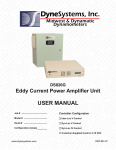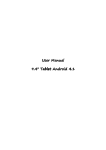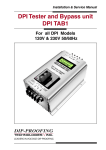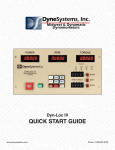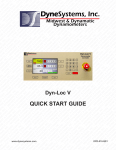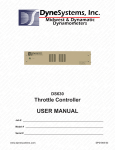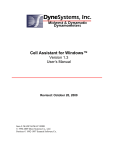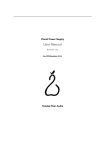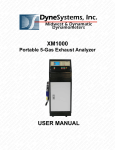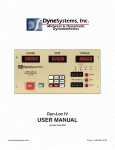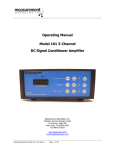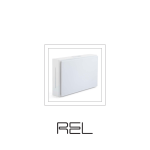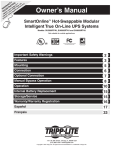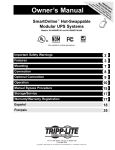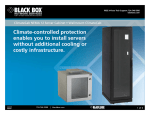Download USER MANUAL - DyneSystems, Inc.
Transcript
N T M S D T D D Y S M S ~ Y & D NA & S, S ~ YN & , IN YN NA T & S, ~ D YN & D NC DY YN ST , I D NA DY IN ~ D DY T & , IN DY AM & D S, I ~ YN & D Y YN M D IN D A D C E M N N A C D A . M N N A & I Y Y N D C N O Y . ~ E OM YN C. YN M YN . ~ S O DY NC NE MO YN ~ M E M DY C. NE OM AM . ~ NE AM YN . ~ E S M NA C. YN MO Y A M SY ET AM ~ M E OM AM MI YS ME NA . ~ S ME M ID SY OM NA ~ M SY E AT MID S OM AM MI YS ETE MA ~ M E S M D D Y Y A W S T T M M S M ID S E A S T AT W TE RS TI IDW YS ETE ATI W EM ER AT ID ST TE TIC ES TE ETE MA IDW TE ER IC WE ST ET AT W TE RS TIC IDW YS C T M R T T R C E M S D S E E IC E M ~ I E M S S I W E R R C D ST S ~ D DY ES EM S DY ST , I ~ C D ES MS S ~ DY T & S, S IC EST S, ~ YN T MS RS D ST S, D DY EST S Y & ,I Y N T S ~ , I D A & D N D IN ~ D ~ Y & IN Y N N & N D Y T , IN ~ D NA D NC NE AM & D , IN DY AM DY C. ~ YN NA & INC YN AM YN C. DY YN & D NC YN MO DY INC D NA DY C. NE AM C Y M YN . ~ S O Y C N O N M E M D . E O A ~ N AM YN . ~ E M N . YN MO N ~ S O . E E N O S E A ~ M M A M Y A S O Y ~ M ~ M E S M AM MID YST ME NA . ~ SY ME MA IDW YS M NA M SY ET AT MID SY OM AM MID YS TE MA M E S ME MA ID ST AT I T ET M ID ST E IC W S E A W T R T ID Y T T W E Y ET A W E TE M M S T T S IC DW ST ER TIC E MS RS ATI IDW TE ER IC EST EM ER AT WE EM RS D ES TE TE TIC E EM S ~ IC WE ST ER IC ES S S E S D T D C Y I ~ D ES E S D ST , M S D M R D YN T M ~ Y & IN ~ D D ES S ~ YN & D S, I S ~ C D ST S, ~ D NA T & S S DY T & , IN DY YN ST MS ~ YN Y T , , IN YN A & S, D N D ~ N N D C & IN N A & C E M D IN Y AM DY . ~ YN NA & INC YN AM YN C. DY YN D C YN MO DY INC DY AM DY C. E M D , IN YN AM . . A E O Y C E M N . N O N ~ S N ~ SY OM YN C. NE OM NA M E S MO DY . ~ E S OM AM ~ M NE M YN ~ AM M S E A ~ S ID Y M N M Y E A I S O A M SY ET AM ~ M E M AM MID YS ME NA . ~ S M ET A IDW TE TE MA M YS ET AT WE ST ET AM ID ST TE TIC DW YS ME MA IDW ST ER AT ID SY ET AT W TE TE MA MID ER TIC E MS RS TI IDW TE ER IC S EM ER AT WE EM RS D ES TE TE TIC E EM S ~ IC WE ST ER IC ES MS RS TIC W M S ~ DY T & S S IC S S ~ YN T M RS D ST S, D DY S EM S DY T , IN ~ D EM S D ST , I ~ C E D , S S ~ S, ~ D YN & D NC DY YN ST , I DY NA DY IN ~ D DY T & , IN DY AM & D , I ~ YN & D INC YN NA T & S, D NA & D C. DY Y N N A C D IN YN M YN . ~ NE AM & D C. NE MO NA . ~ YN NA DY C. NE OM YN C. DY AM YN . ~ E S MO DY INC YN MO YN ~ M NE YN C E O A M S O Y ~ ~ M M M E MO NA M SY E AM ~ NE OM AM M YS ME NA . ~ E S M AM ID S . S M I N M D ~ Y ET AM M SY E A W S M A M YS ET AT ID SY M M ID S TE A M S E A ID T T M M Y ET A W E M ID S E T E T T T R T ID Y T T W E E A W E A E I M ER AT IDW STE ER IC ES TEM TE AT W TE RS C D E STE TE TI WE EM S IC W ST ER IC ES MS RS TI IDW TE RS IC C C D S R S, S IC ~ E M E ES MS S ~ DY T & S, S IC ST S, ~ YN T MS RS D ST S, D DY ST EM S ~ DY T & , IN ~ D D ES MS ~ Y ~ I D Y & IN Y N Y T , D D A & S & NC D Y T , N N D I ~ D C D . YN NA & IN DY AM YN NC DY YN & D INC YN MO DY , IN ~ D NA D C. NE AM & D , IN DY AM DY . ~ YN NA & INC YN Y Y ~ C N C . D N E O NA M E S MO DY . ~ E OM AM ~ M NE AM YN . ~ E S ME NA . ~ YNE MO NA ~ M SY OM YN C. E OM NA MI S MO YN . ~ M M M ID Y M N M SY E A I S O A M Y T M M D ~ Y S M M S A M ET A W S E A TI DW Y M MA ID ST ER AT ID SY ET MA IDW TE ETE MA M YS ET AT WE ST ET AM I T S I M D E E E T T I T ST E I E E T S C T IC S E E A M R T D T S E I T W E S I EM RS C D ST M ER ATI WE EM RS DY ES TEM TER IC ES MS ~ C D WE TE RS C D EST S, S IC WE EM RS D T MS RS TI ES S ~ Y & S, S C ST S, ~ N T S DY T & , I DY YN ST MS ~ YN & IN ~ D DY ST S, ~ D YN & D , IN ~ S & D D ~ A N I T , IN DY A DY N D Y & IN Y M D , IN ~ N D NC N A & , D A D C. Y N & IN Y AM Y C D AM & D C N MO NA C. YN NA DY C. NE OM YN C DY AM YN . ~ E S MO DY INC YN MO YN ~ M NE AM D C. NE O NA . ~ S O Y ~ S M M Y .~ E E M N ~ S E A .~ N O A M Y M N . E M A M M ~ YS OM NA M SY ET AT MID S OM AM MID YS TE MA M E S ME M ID ST ET AM ~ M SY ET MA IDW YS ME NA MI YS ET AT TE ET MA IDW ST ER IC W YS ET AT W TE RS TIC IDW YS TE ATI WE EM ER AT ID ST ER TIC ES TE TE MA DW TE ER IC ST M ER T E EM S D ES TE E IC E M ~ TE R C ST S, S IC WE EM S D T MS RS TIC ES MS S ~ E S D Y I D S R S M S C T S S ~ S ~ Y & I ~ D D T D Y S M AM & D , IN ~ D T & , IN D NA & S, S ~ YN & , IN YN NA T & S ~ D YN & D NC DY YN ST S, I D NA DY , IN ~ D DY T & , IN Y , Y Y M O YN C. DY NA D C. NE O DY INC DY AM DY C. E MO D IN YN AM YN . ~ NE AM & D NC NE MO NA C. ~ YN NA DY C. N M . C Y Y ~ N S O M A M N ST E M ~ E MO NA ~ M S E AM . ~ NE OM A M YS M NA . ~ E S M AM ID SY OM YN ~ M S ME MA M E S MO NA M Y Y T E T A I S E M I E M M M A T ID ID MS ER TIC DW YS ME MA IDW ST ER AT ID SY ET AT DW TE TE MA MID YS TE ATI WE STE ET MA IDW ST TER IC W YS ET M T T W ,I S D ES TE TE TIC ES EM S ~ IC D WE STE ER IC ES S RS TIC W EM RS C D ST MS ER TIC E EM S DY ES EM E ~ N E IC S C D YN T M R S S ~ N T S ~ Y & D T S D Y S M S D T ,I ~ D E D T & . ~ YN A & S, S ~ YN & , IN YN NA T & S ~ D YN & D NC DY YN ST S, I D NA DY , IN ~ D DY T & , IN DY AM & D S, I Y , M D I N Y A C YN NA DY MI E S O YN NC DY AM DY C. ~ E S MO DY INC YN MO YN . ~ NE AM & D C. NE MO NA . ~ YN NA DY C. ~ NE OM YN D M M N E MO NA W YS E AM . ~ NE OM A M YS M NA . ~ E S M AM ID SY OM YN ~ M S ME MA M E S MO NA M SY ET A ID SY M M ES TE TE A M S E MA ID T ET M M Y ET A W S E AM ID YS T TI IDW Y ME MA ID ST ER S W E W S E AT T M RS TI ID YS TE TI W EM ER AT ID ST E TIC ES TE TE A W TE ER C E T T T DS820F Power Amplifier Unit USER MANUAL Job # ____________________ www.dynesystems.com Controller Configuration Model # __________________ Inter-Loc V Control Serial # __________________ Dyn-Loc IV Control Configuration (amps) _______ Customer-Supplied Control, 0-10 VDC DPD-001-04B From Dyne Systems, Inc. The DS820F Power Amplifier Unit (PAU) is a third generation, intelligent universal Eddy Current Power Amplifier Unit. It is an analog controller with a digital front end that offers greater flexibility for upgrading existing test cells, or for entirely new test installations. The potential applications for the PAU range from simple manual control to fully integrated closed loop installations. The PAU interfaces with all of Dyne Systems’ existing dynamometer controllers, as well as industrial PC/PLC 24 VDC logic-based controllers running third party software. The PAU provides a unique set of features: • Set up is simple and straightforward. • The front panel diagnostic LCD display eliminates guesswork by displaying real time field current, input command, status and fault messages. • System status can also be reported via PLC level I/O to external controls. • An analog voltage or current input enables the unit to be used as a standalone open loop eddy current power amplifier. • It can be integrated into existing test cells with fully integrated closed loop control units. • The modular construction of the PAU allows it to be interfaced with different dynamometer control components. The PAU is available in wall mount or in a space saving and reduced wiring rack mount version. It also provides significantly increased current capabilities with ratings of 15, 30, 50 and 100 amps at up to 400 VDC. Higher non-standard current ratings can easily be custom engineered. For customers who prefer to get leading edge performance and test cell system integration from a single provider, Dyne Systems’ new PAU fully integrates with Dyne Systems’ dynamometer controls and eddy current dynamometers. NOTE: This manual is intended for use by qualified personnel only. All Dyne Systems’ approved drawings (if included) and specific instructions for this equipment must take precedence over general information contained in this manual. Thank you for purchasing this product from Dyne Systems. Our staff is at your disposal, should you need information or support that is not found in this manual. CONTROLS, DYNAMOMETERS, SYSTEM INTEGRATION AND TEST CELL AUTOMATION Dyne Systems, Inc. • W209 N17391 Industrial Drive • Jackson, Wisconsin 53037 phone: 800.657.0726 • website: www.dynesystems.com Dyne Systems • DS820F PAU DPD-001-04B • © Copyright Dyne Systems, Inc. Introduction 1 TABLE OF CONTENTS SECTION 1: GENERAL INFORMATION 4 SAFETY...................................................................................................................................4 RECEIVING INSPECTION......................................................................................................4 DAMAGE CLAIMS...................................................................................................................4 TRAINING................................................................................................................................4 IDENTIFY YOUR PAU..............................................................................................................4 SECTION 2: CONFIGURATION 5 MODES OF RESET OPERATION...........................................................................................8 SECTION 3: SECTION 4: INSTALLATION ENVIRONMENT TRANSFORMER COMPATIBILITY 9 10 WALL MOUNT PAU, COIL AND TRANSFORMER COMPATIBILITY TABLE......................... 10 RACK MOUNT PAU, COIL AND TRANSFORMER COMPATIBILITY TABLE......................... 11 SECTION 5: INSTALLATION AND START UP 12 WHO SHOULD INSTALL THE PAU....................................................................................... 12 WALL MOUNT INSTALLATION.............................................................................................. 12 ENCLOSURE SPECIFICATIONS.......................................................................................... 12 DIMENSIONS........................................................................................................................ 12 WALL MOUNT MECHANICAL INSTALLATION..................................................................... 13 WALL MOUNT WIRING......................................................................................................... 13 WALL MOUNT TERMINAL BLOCK CONNECTIONS............................................................ 14 WALL MOUNT SUBPANEL................................................................................................... 15 WALL MOUNT START-UP..................................................................................................... 16 INTER-LOC V START-UP....................................................................................................... 16 DYN-LOC IV AND CUSTOMER-SUPPLIED CONTROL START-UP...................................... 17 RACK MOUNT INSTALLATION............................................................................................. 18 ENCLOSURE SPECIFICATION . .......................................................................................... 18 DIMENSIONS........................................................................................................................ 18 RACK MOUNT MECHANICAL INSTALLATION..................................................................... 19 RACK MOUNT WIRING......................................................................................................... 19 RACK MOUNT START-UP.....................................................................................................21 INTER-LOC V START-UP.......................................................................................................21 DYN-LOC IV AND CUSTOMER-SUPPLIED CONTROL START-UP......................................22 SECTION 6: PREVENTIVE MAINTENANCE 23 WALL MOUNT.......................................................................................................................23 RACK MOUNT.......................................................................................................................23 2 Dyne Systems • DS820F PAU DPD-001-04B • © Copyright Dyne Systems, Inc. Table of Contents SECTION 7: APPLICATION SPECIFIC FUNCTIONALITY 24 COMMAND VOLTAGE SCALING...........................................................................................24 CURRENT FEEDBACK.........................................................................................................24 SCALED CURRENT FEEDBACK..........................................................................................24 DYN-LOC IV INTERFACE......................................................................................................24 50HZ / 60HZ OPERATION.....................................................................................................24 LOW INDUCTANCE COIL.....................................................................................................24 LOW MAX CURRENT............................................................................................................24 0-20MA COMMAND SOURCE..............................................................................................24 ADDITIONAL SAFETIES.......................................................................................................25 DS820F CONTROL BOARD JUMPER DEFINITIONS..........................................................25 SECTION 8: FAULTS / TROUBLESHOOTING 26 WALL MOUNT AND RACK MOUNT TROUBLESHOOTING GUIDE.....................................26 WALL MOUNT SIGNALS.......................................................................................................28 RACK MOUNT SIGNALS......................................................................................................30 SECTION 9: CUSTOMER SUPPORT 31 SECTION 10: PRODUCT WARRANTY 32 APPENDIX A: PAU MAX CURRENT ADJUSTMENT 33 APPENDIX B: OHM’S LAW 35 APPENDIX C: DRAWINGS AND SCHEMATICS 36 RACK MOUNT CONNECTIONS - 15 AMP............................................................................36 RACK MOUNT CONNECTIONS - 30 AMP............................................................................37 WALL MOUNT SCHEMATIC.................................................................................................38 APPENDIX D: CURRENT MODULE REQUIRED CONDUCTOR DEFINITION39 APPENDIX E: ACRONYMS Dyne Systems • DS820F PAU DPD-001-04B • © Copyright Dyne Systems, Inc. 40 Table of Contents 3 SECTION 1: GENERAL INFORMATION Within this manual, Dyne Systems, Inc. will be referred to as “DS”. SAFETY Read your instruction manual! Electrical rotating equipment can be dangerous. Become familiar with all safety instructions and procedures. WARNING, CAUTION and NOTE labels are used throughout the manual to remind you of the hazards that exist. Know your equipment before handling or working on it. Used to warn of the possibility of injury to personnel and damage to equipment Used to caution of the potential hazards and unsafe practices NOTE: Used for special instructions related to safety, proper operation or maintenance RECEIVING INSPECTION Upon the arrival of your equipment, check all items received against the packing slip to ensure the shipment is complete. Then inspect for damage. Any evidence of rough handling may be an indication of hidden damage. Be sure to perform the following inspections: 1. Inspect packaging and skid(s) for any mistreatment. Document and photograph any signs of damage. 2. Inspect housing to ensure there is no damage and that unit is intact. DAMAGE CLAIMS In the event of damage, report it without delay to the carrier and Dyne Systems. Dyne Systems’ warranty policy does not cover shipping damage or lost material. It is important to file a damage claim with the carrier promptly. If you require assistance in settling the claim, contact Dyne Systems. Refer to equipment by purchase order, model, serial and job numbers, as shown on the nameplate of the unit involved. TRAINING Training programs are an essential part of safe and correct operation. Training provides the know-how necessary to obtain top performance from your equipment. Dyne Systems recognizes this fact and offers training classes on-site or at the factory to educate personnel in safe operating and maintenance procedures. IDENTIFY YOUR PAU This PAU was configured at DS for your specific application. The PAU will be physically configured as either wall mount or rack mount. Review the diagrams and verify your configuration: Dyne Systems Inter-Loc V Control (see Figure 2.1 on Page 5). Dyne Systems Dyn-Loc IV Control (see Figure 2.2 on Page 6). Customer-Supplied Control: this requires 0-10VDC or 0-20mA Control Signal (see Figure 2.3 on Page 7). Locate the model and serial numbers on the PAU and verify that they are the same as that shown on the cover of this manual. This information should be used when contacting DS customer support. 4 Dyne Systems • DS820F PAU DPD-001-04B • © Copyright Dyne Systems, Inc. General Information CUST xxxVAC SINGLE PHASE + GROUND DISCONNECT Dyne Systems • DS820F PAU DPD-001-04B • © Copyright Dyne Systems, Inc. Configuration MIDWEST MW-xxxx HP xxxxHP ABSORB RPM xxx/xxx FIELD xxxV @ xxA EC DYNAMOMETER __"x__"x__" JB JB CONDUIT S1* SPEED/TRQ FB CONDUIT S3* H20 SAFETIES FLOW OR PRESSURE OR TEMP CONDUIT S2* ECPAU CONTROL TEST CELL Digital Multi-Loop Dynamometer and Engine Controller CA4W COMPUTER MONITOR OCS POWER SUPPLY INTER-LOC V XFMR INTER-LOC V OCS INTER-LOC V CONTROL CONSOLE 7" 5 1/4" Figure 2.1 - Inter-Loc V Controller Configuration with Wall Mount ECPAU (Optional Rack Mount) LOAD CELL JB 20" x 16" x 8" ~40 LBS ECPAU xxA CONDUIT P2* FACILITY VAC xxxVAC @ xxA MAG PU CONDUIT P5* EC DYNO FIELD xxxVDC @ xxA CONDUIT P4* ISOLATED VAC xxxVAC @ xxA CONDUIT P3* FACILITY VAC xxxVAC @ xxA MINIMUM SPACE OF 12" ON EITHER SIDE OF ECPAU FOR COOLING AIR FLOW TRANSFORMER T1 FIELD POWER -- KVA --- LBS --" x --" x --" CONDUIT P1* FACILITY VAC xxxVAC @ xxA CNTRL XFMR ---/-----KVA ---LBS -"x-"x-" DISCONNECT OPTIONAL(IF 115VAC NOT AVAILABLE) INTER-LOC V CONTROL INTER-LOC V OCS CONDUIT P7* FACILITY VAC xxxVAC @ xxA CONDUIT P6* FACILITY VAC 115VAC @ 15A 19" W209 N17391 Industrial Dr. Jackson, WI 53037 Fax: 1-262-677-9308 Phone: 1-262-677-9300 www.DyneSystems.com Inter-Loc V SECTION 2: CONFIGURATION 5 CUST xxxVAC SINGLE PHASE + GROUND 6 DISCONNECT Dyne Systems • DS820F PAU DPD-001-04B • © Copyright Dyne Systems, Inc. __"x__"x__" MIDWEST MW-xxxx HP xxxxHP ABSORB RPM xxx/xxx FIELD xxxV @ xxA EC DYNAMOMETER JB JB CONDUIT S1* SPEED/TRQ FB CONDUIT S3* H20 SAFETIES FLOW OR PRESSURE OR TEMP CONDUIT S2* ECPAU CONTROL TEST CELL CA4W COMPUTER MONITOR DYN-LOC IV CONSOLE Figure 2.2 - Dyn-Loc IV Controller Configuration with Wall Mount ECPAU (Optional Rack Mount) LOAD CELL JB 20" x 16" x 8" ~40 LBS ECPAU xxA CONDUIT P2* FACILITY VAC xxxVAC @ xxA MAG PU CONDUIT P5* EC DYNO FIELD xxxVDC @ xxA CONDUIT P4* ISOLATED VAC xxxVAC @ xxA CONDUIT P3* FACILITY VAC xxxVAC @ xxA MINIMUM SPACE OF 12" ON EITHER SIDE OF ECPAU FOR COOLING AIR FLOW TRANSFORMER T1 FIELD POWER -- KVA --- LBS --" x --" x --" CONDUIT P1* FACILITY VAC xxxVAC @ xxA CONDUIT P6* FACILITY VAC 115VAC @ 15A RPM/TORQUE ACTIVE LOCK ACTIVE TORQUE CNTRL XFMR ---/-----KVA ---LBS -"x-"x-" DISCONNECT OPTIONAL(IF 115VAC NOT AVAILABLE) RPM DYNLOC CONDUIT P7* FACILITY VAC xxxVAC @ xxA EMERG STOP DYN><LOC POWER CONFIGURATION (CONTINUED) Configuration CUST xxxVAC SINGLE PHASE + GROUND DISCONNECT Dyne Systems • DS820F PAU DPD-001-04B • © Copyright Dyne Systems, Inc. Configuration __"x__"x__" MIDWEST MW-xxxx HP xxxxHP ABSORB RPM xxx/xxx FIELD xxxV @ xxA EC DYNAMOMETER JB JB CONDUIT S1* SPEED/TRQ FB CONDUIT S3* H20 SAFETIES FLOW OR PRESSURE OR TEMP CONDUIT S2* ECPAU CONTROL TEST CELL CUSTOMER SUPPLIED CONTROLS CONSOLE Figure 2.3 - Customer-Supplied Controller, 0-10 VDC or 0-20mA Control Signal with Wall Mount ECPAU (Optional Rack Mount) LOAD CELL JB 20" x 16" x 8" ~40 LBS ECPAU xxA CONDUIT P2* FACILITY VAC xxxVAC @ xxA MAG PU CONDUIT P5* EC DYNO FIELD xxxVDC @ xxA CONDUIT P4* ISOLATED VAC xxxVAC @ xxA CONDUIT P3* FACILITY VAC xxxVAC @ xxA MINIMUM SPACE OF 12" ON EITHER SIDE OF ECPAU FOR COOLING AIR FLOW TRANSFORMER T1 FIELD POWER -- KVA --- LBS --" x --" x --" CONDUIT P1* FACILITY VAC xxxVAC @ xxA CONDUIT P6* FACILITY VAC 115VAC @ 15A CONDUIT P7* FACILITY VAC xxxVAC @ xxA CNTRL XFMR ---/-----KVA ---LBS -"x-"x-" DISCONNECT OPTIONAL(IF 115VAC NOT AVAILABLE) CONFIGURATION (CONTINUED) 7 MODES OF RESET OPERATION The PAU has two modes of operation: Reset Required Mode and Automatic Reset Mode. In the Reset Required Mode, the PAU will require a reset after the application of power or after a fault condition has occurred. This reset signal is generated by the dynamometer control system. During a reset condition, a +24 VDC signal is momentarily applied to TB1-6 on the wall mount version, or pin 15 of the 25-pin Dynamometer Control Connector on the rear of the rack mount version. Reset Required Mode is the default mode of operation when used in conjunction with an Inter-Loc V controller. In the Automatic Reset Mode, no reset will be required at power up and the following fault conditions will self restore: SCR OverTemp, Coolant OverTemp, Low Coolant Pressure/Flow, Current OverCmd and GP Input Fault X. The Automatic Reset Mode is the default mode of operation when used in conjunction with a Dyn-Loc IV controller. xercise caution when using the PAU in the Automatic Reset Mode, as the PAU E could unexpectedly apply power to the coil resulting in excessive heating and possible failure if proper cooling is not supplied. When a customer-supplied control system is used, Dyne Systems will configure the PAU to the mode of choice. If the customer does not specify the mode of operation at the time of order, it will be set to the Reset Required Mode. 8 Dyne Systems • DS820F PAU DPD-001-04B • © Copyright Dyne Systems, Inc. Configuration SECTION 3: INSTALLATION ENVIRONMENT The PAU should be mounted so it is not exposed to severe shock and/or vibrations. If adverse conditions are anticipated, the PAU can be mounted using vibration-damping materials. The atmosphere should be free of corrosive gases, vapors or particulates that could cause fire or explosion. Relative humidity should be 0 to 95% non-condensing. Temperature range should be 32 to 90° F (0 to 32.2° C). Dyne Systems • DS820F PAU DPD-001-04B • © Copyright Dyne Systems, Inc. Installation Environment 9 SECTION 4: TRANSFORMER COMPATIBILITY It is important that the PAU, the Dynamometer Coil, and the Transformer are compatible. The following tables can be used to check these components in your system. Wall Mount PAU, Coil and Transformer Compatibility Table PAU Transformer Coil Wall Mount PAU Model No. Current Specifications Facility Power (Primary) PAU Input Power (Secondary) Calculated Transformer VA Max. Volts DC Output Max. Coil Current UEC-PAU-15-W01 15 amp 208 240 3,600 200 15 15 amp 208 277 4,155 250 15 15 amp 240 240 3,600 200 15 15 amp 240 277 4,155 250 15 15 amp 480 240 3,600 200 15 15 amp 480 277 4,155 250 15 UEC-PAU-15-W04 15 amp 208 480 7,200 400 15 UEC-PAU-15-W05 15 amp 240 480 7,200 400 15 UEC-PAU-15-W06 15 amp 480 480 7,200 400 15 UEC-PAU-30-W01 30 amp 208 240 7,200 200 30 UEC-PAU-30-W02 30 amp 240 240 7,200 200 30 30 amp 480 480 14,400 400 30 UEC-PAU-30-W03 30 amp 208 277 8,310 250 30 UEC-PAU-30-W04 30 amp 240 277 8,310 250 30 UEC-PAU-30-W05 30 amp 480 240 7,200 200 30 UEC-PAU-30-W06 30 amp 480 277 8,310 250 30 UEC-PAU-30-W07 30 amp 208 480 14,400 400 30 UEC-PAU-30-W08 30 amp 240 480 14,400 400 30 UEC-PAU-50-W01 50 amp 208 240 12,000 200 50 50 amp 208 277 13,850 250 50 50 amp 240 240 12,000 200 50 50 amp 240 277 13,850 250 50 UEC-PAU-50-W03 50 amp 480 240 12,000 200 50 UEC-PAU-50-W03 50 amp 480 277 13,850 250 50 UEC-PAU-50-W04 50 amp 480 480 24,000 400 50 UEC-PAU-100-W01 100 amp 480 240 24,000 200 100 UEC-PAU-15-W02 UEC-PAU-15-W03 UEC-PAU-50-W02 10 Dyne Systems • DS820F PAU DPD-001-04B • © Copyright Dyne Systems, Inc. Transformer Compatibility RACK MOUNT PAU, COIL AND TRANSFORMER COMPATIBILITY TABLE PAU Transformer Coil Rack Mount PAU Model No. Current Specifications Facility Power (Primary) PAU Input Power (Secondary) Calculated Transformer VA Max. Volts DC Output Max. Coil Current UEC-PAU-15-R01 15 amp 208 240 3,600 200 15 15 amp 208 277 4,155 250 15 15 amp 240 240 3,600 200 15 15 amp 240 277 4,155 250 15 30 amp 208 240 7,200 200 30 30 amp 208 277 8,310 250 30 30 amp 240 240 7,200 200 30 30 amp 240 277 8,310 250 30 UEC-PAU-30-R01 Dyne Systems • DS820F PAU DPD-001-04B • © Copyright Dyne Systems, Inc. Transformer Compatibility 11 SECTION 5: INSTALLATION AND START UP WHO SHOULD INSTALL THE PAU The DS820F PAU operates as part of a system. If the system is not properly wired, equipment may be damaged. Only a qualified licensed electrician should install the DS820F PAU. All installations should comply with the most current version of the National Electric Code (NEC) as well as all local codes. WALL MOUNT INSTALLATION Enclosure Specifications The Enclosure for the wall mount PAU meets the following industry standards: UL 50, File No.E27567 Type I; NEMA/EEMAC Type I; CSA, File No.42184 Type I; IEC 60529, IP30. The PAU enclosure does not meet oil-tight or dust tight specifications. Dimensions 8.62 (219) inches (mm) 8.0 (203) 16.0 (406) 20.0 (508) Recommended 12” Mounting Clearance 11.0 (279) 0.31 (8) 1.5 (38) 2.5 (64) 1.06(27) 17.0 (432) 14.5 (368) 12 Dyne Systems • DS820F PAU DPD-001-04B • © Copyright Dyne Systems, Inc. 17.8 (454) Figure 5.1 - Dimensions Installation & Start Up Wall Mount Mechanical Installation The PAU should be mounted in the vertical position (Refer to Figure 5.1). It is required that 12” of clearance around the entire PAU be provided to allow for filter changes and adequate airflow around the cabinet. The method of mounting the PAU to a vertical surface is the responsibility of the end-user. Wall Mount Wiring Once the PAU is securely mounted, and all conduits with the appropriate wires are in place: 1. Open the access panel and route the wires into the panel. 2. Connect the wires according to the prints provided (Refer to Figure 5.2). Note: The prints provided with the PAU take priority over this manual. It is likely that not all of the terminal connections will be used. The PAU has safety inputs in the form of Coolant Temperature and Coolant Pressure/ Flow. Additionally there are three spare generic safety inputs. These inputs have different functionality and correct wiring must be observed Note: All digital inputs to and outputs from the PAU terminals are PLC +24VDC logic. The Current Command (TB1-2 - TB1-3) is an analog signal of 0-10 VDC or 0-20mA. Both single ended and differential inputs can be configured. The Dyne On command is required to enable the controller; a dry contact wired between terminals TB1-4 and TB1-5 can be used in lieu of a PLC or controller. 3. Close the access door and secure Dyne Systems • DS820F PAU DPD-001-04B • © Copyright Dyne Systems, Inc. Installation & Start Up 13 Wall Mount Terminal Block Connections Figure 5.2 - Wall-Mount Terminal Block Connection s Figure 5.3 - Enlarged view of terminal block 14 Dyne Systems • DS820F PAU DPD-001-04B • © Copyright Dyne Systems, Inc. Installation & Start Up Wall Mount Subpanel Snubber Board SCR Bridge and Heatsink Control Transformer Fuses DS820 Control Board Current Transducer Main Fuses Terminal Blocks Figure 5.4 - Wall Mount Subpanel Dyne Systems • DS820F PAU DPD-001-04B • © Copyright Dyne Systems, Inc. Installation & Start Up 15 WALL MOUNT START-UP Inter-Loc V Start-Up 1. Validate that the configuration listed on the cover of the manual, exterior of the unit, and the sub-panel are identical and appropriate for your application. If these values do not match or are not appropriate for your application, please contact DS. 2. Verify the integrity of power wiring (i.e. no shorts to ground, verify coil resistance, etc). 3. Power up the Inter-Loc V / OCS. 4. Apply power to the PAU. 5. The following will appear on the display for ~3 seconds: Eddy-Current PAU XX.X A max VX.X XX.XA - The maximum current of the PAU (15, 30, 50, 100) VX.X - The version of firmware The display will then change to the following: Not Self Res. Reset Required Not Self Res. Reset Required - Requires a manual reset after the application of power or after a fault condition has occurred. 6. Push the RESET button on the OCS to initiate the system. 7. The following will appear on the display: PAU:Ok 0% Off 0.0A PAU:Ok - Signifies everything is okay, or else the word Fault is displayed (refer to Wall Mount Signals Troubleshooting Guide on page 26). Off - PAU is not enabled % - Percentage of command signal 0-10 VDC or 0-20mA A - Amount of current being applied to coil If Fault is displayed, power down the Inter-Loc V and PAU, correct the fault, and then go back to Step 3. 16 8. Perform the Max Current adjustment if this is the first time use. (See Appendix A, p. 32 for setting Max Current.) 9. Your DS820F PAU is ready for use. Dyne Systems • DS820F PAU DPD-001-04B • © Copyright Dyne Systems, Inc. Installation & Start Up Dyn-Loc IV and Customer-Supplied Control Start-Up hen the PAU is powered up in the Automatic Reset Mode the dynamometer W could power up in the same state it was in when power was turned off. 1. Validate that the configuration listed on the cover of the manual, exterior of the unit, and the sub-panel are identical and appropriate for your application. If these values do not match or are not appropriate for your application, please contact Dyne Systems. 2. Verify the integrity of power wiring (i.e. no shorts to ground, verify coil resistance, etc). 3. Power up the Dyn-Loc IV (or customer controls). 4. Apply power to the PAU. When power is applied a reset is not required. The following faults are self-restoring: • SCR OverTemp • Current OverCmd • Coolant OverTemp • Spare Safeties • Coolant P/F The following faults require the power to be turned off and the fault corrected before reapplying power: • I Current Err • Current Reversed • No Field Current 5. The following will appear on the display for ~3 seconds: Eddy-Current PAU XX.X A max VX.X XX.XA - The maximum current of the PAU (15, 30, 50, 100) VX.X - The version of firmware 6. The following will then appear on the display: PAU:Ok Off 0% 0.0A PAU:Ok - Signifies everything is okay, or else the word Fault is displayed (refer to Wall Mount Troubleshooting Guide on page 26). Off - PAU is not enabled % - Percentage of command signal 0-10VDC or 0-20mA A - Amount of current being applied to coil If Fault is displayed, power down the Dyn-Loc IV (or customer controls) and PAU, correct the fault and go back to Step 3. 7. Perform the Max Current adjustment if this is the first time use. (See Appendix A, p.32 for setting Max Current.) 8. Your DS820F PAU is ready for use. Dyne Systems • DS820F PAU DPD-001-04B • © Copyright Dyne Systems, Inc. Installation & Start Up 17 RACK MOUNT INSTALLATION Enclosure Specification The DS820F PAU enclosure for the rack style PAU is designed for use in areas which do not require oil-tight and dust-tight applications. Fans are used to cool the interior. The intake is at the front of the unit. Dimensions Figure 5.5 - Rack Mount Dimensions 18 Dyne Systems • DS820F PAU DPD-001-04B • © Copyright Dyne Systems, Inc. Installation & Start Up Rack Mount Mechanical Installation The PAU enclosure is designed to install in a standard 19 inch server rack using supplied rack mount brackets. The method of securing the rack frame and mounting the PAU in the rack is the responsibility of the end user. If access to the back of the unit is available the PAU shall be securely mounted before any connections are made. 1. Connect wires according to the 15 Amp wiring diagram (Figure 5.6) or 30 Amp wiring diagram (Figure 5.7). 2. When connections are secure, the PAU should be in position and mounted to the rack. Rack Mount Wiring Figure 5.6 - 15 Amp Rack Mount PAU Back Panel Connections Dyne Systems • DS820F PAU DPD-001-04B • © Copyright Dyne Systems, Inc. Installation & Start Up 19 RACK MOUNT WIRING (CONTINUED) Figure 5.7 - 30 Amp Rack Mount PAU Back Panel Connections 20 Dyne Systems • DS820F PAU DPD-001-04B • © Copyright Dyne Systems, Inc. Installation & Start Up RACK MOUNT START-UP Inter-Loc V Start-Up 1. Validate the configuration listed on the cover of the manual and exterior of unit are identical and appropriate for your application. If these values do not match or are not appropriate for your application, please contact Dyne Systems. 2. Verify the integrity of power wiring (i.e. no shorts to ground, verify coil resistance, etc). 3. Power up the Inter-Loc V / OCS. 4. Apply power to the PAU. 5. The following will appear on the display for ~3 seconds: Eddy-Current XX.X A max PAU VX.X XX.XA - The maximum current of the PAU (15, 30, 50, 100) VX.X - The version of firmware The display will then change to the following: Not Self Res. Reset Required Not Self Res. Reset Required - Requires a manual reset after the application of power or after a fault condition has occurred. 6. Push the RESET button on the OCS to Initiate the System. 7. The following will appear on the display: PAU: Ok 0% Off 0.0A PAU:Ok - signifies everything is okay, or else the word Fault is displayed (refer to Rack Mount Troubleshooting Guide on page 26). Off - PAU is not enabled % - Percentage of command signal 0-10VDC or 0-20mA A - Amount of current being applied to coil If Fault is displayed, power down the Inter-Loc V and PAU, correct the fault, and then go back to Step 3. 8. Perform the Max Current adjustment if this is the first time use. (See Appendix A, p.32 for setting Max Current.) 9. Your DS820F PAU is ready for use. Dyne Systems • DS820F PAU DPD-001-04B • © Copyright Dyne Systems, Inc. Installation & Start Up 21 DYN-LOC IV AND CUSTOMER-SUPPLIED CONTROL START-UP hen the PAU is powered up in the Automatic Reset Mode, the W dynamometer could power up in the same state it was in when power was turned off. 1. Validate the configuration listed on the cover of the manual and exterior of the unit are identical and appropriate for your application. If these values do not match or are not appropriate for your application, please contact Dyne Systems. 2. Verify the integrity of power wiring (i.e. no shorts to ground, verify coil resistance, etc). 3. Power up the Dyn-Loc IV (or customer control). 4. Apply power to the PAU. When power is applied a reset is not required. The following faults are self-restoring: • SCR OverTemp • Current OverCmd • Coolant OverTemp • Spare Safeties • Coolant P/F The following faults require the power to be turned off and the fault corrected before reapplying power: • I Current Err • Current Reversed • No Field Current 5. The following will appear on the display for ~3 seconds: Eddy-Current XX.X A max PAU VX.X XX.XA - The maximum current of the PAU (15, 30, 50, 100) VX.X - The version of firmware 6. The following will then appear on the display: PAU:Ok 0% Off 0.0A PAU:Ok - Signifies everything is okay, or else the word Fault is displayed (Refer to Rack Mount Troubleshooting Guide on page 26). Off - PAU is not enabled % - Percentage of command voltage 0-10VDC or 0-20mA A - Amount of current being applied to coil If Fault is displayed, power down the Dyn-Loc IV (or customer control) and PAU, correct the fault, and then go back to Step 3. 22 7. Perform the Max Current adjustment if this is the first time use. (See Appendix A, p.32 for setting Max Current.) 8. Your DS820F PAU is ready for use. Dyne Systems • DS820F PAU DPD-001-04B • © Copyright Dyne Systems, Inc. Installation & Start Up SECTION 6: PREVENTIVE MAINTENANCE WALL MOUNT The only maintenance items on the wall mount PAU are the cabinet air filter elements. It is recommended that the filter elements be removed, cleaned, and inspected every month. Use the following procedure to perform the routine maintenance: 1. De-energize all power source(s) prior to maintaining the filter assembly 2. Grasp the louvered cover and pull to snap open. 3. Remove filter element. 4. Wash with mild detergent and warm water. 5. Allow filter to air dry. 6. Insert clean filter element into the filter body. 7. Snap louvered cover into place. 8. Reapply power source(s). RACK MOUNT The only maintenance items on the rack mount PAU are the air vents and cooling fan(s). It is recommended that the air vents and cooling fans(s) be inspected monthly and any dust or debris be removed. Dyne Systems • DS820F PAU DPD-001-04B • © Copyright Dyne Systems, Inc. Preventive Maintenance 23 SECTION 7: APPLICATION SPECIFIC FUNCTIONALITY Command Voltage Scaling The command voltage input is typically a 0 to +10 VDC signal. Zero and span adjustments are available to accommodate non-standard input voltages. Use potentiometer P7 to zero and P8 to span the input command voltage while measuring at TP23(+) and TP20(-) for 0 and +10 VDC. Install JP12 to enable P7 if zeroing is needed. Current Feedback This feedback signal is a representation of the output current as seen by the current control loop within the DS820F circuit board. The signal is buffered and is available at TB15 on the DS820F circuit board. Note: This signal is used for troubleshooting. Please reference Appendix D for more information. Scaled Current Feedback This scaled signal represents a value proportional to 0-100% (0-10 VDC) of the ECPAU current limit. This signal is available at TB5 in a Wall Mount version or within the “Dyno Control” connector in a Rack Mount version if JP13 is installed on the DS820F circuit board. Dyn-Loc IV Interface Using the DS820F PAU with a Dyne Systems Dyn-Loc IV controller requires some unique connections. TB2-1 thru TB2-6 on the wall mount unit and certain pins of the AUX connector on the rack mount are available for some of the Dyn-Loc IV specific signals. Jumper JP6 needs to be in POS B and the command input set for differential mode. This mode of operation is normally configured at the factory. 50Hz / 60Hz Operation Jumper JP14 allows the DS820F to be configured for either 50Hz or 60Hz operation. Do not move this jumper without first contacting Dyne Systems. Low Inductance Coil Jumper JP2 should be installed when using a low inductance coil. Low inductance is indicated by a greater than 20% ripple on the dynamometer waveform (seen on oscilloscope). Low Max Current If the Dynamometer coil rating is less than 25% of the ECPAU rating, install JP7 before adjusting the current limit potentiometer P3. This ensures correct current regulation in the Dynamometer by the ECPAU. 0-20mA Command Source Jumper JP1 allows use of a standard 0-20mA current command signal. Install JP1 to enable this option. 24 Dyne Systems • DS820F PAU DPD-001-04B • © Copyright Dyne Systems, Inc. Application Specific Functionality Additional Safeties In addition to the two H2O safeties (Coolant Temp and Coolant P/F) there are three inputs available for custom safeties or faults. TB3-1 thru TB3-6 provide connections for up to three dry contacts (closed = OK to run). Opening of these contacts will generate a fault. The LCD display will show “GP Input Fault 1, 2 or 3”. This message can be customized at the factory if desired. The DS820F ships with jumpers in these inputs. Note: Reference Table 7.1 (next page) for all jumper definitions. DS820F Control Board Jumper Definitions Jumper Description IN = Current Input (0-20mA) Default Positiion Installed OUT NO (Hanging) OUT NO (Hanging) JP1 OUT = Voltage input (0-10 VDC) JP2 Low Inductance Coil Jumper JP3 External Current Command Source = Rack Mount OUT NO (Hanging) JP4 External Current Command Source = Wall Mount IN YES JP5 External Armature Feedback from TB9 OUT NO (Hanging) JP6 IL5 / TB12 Dyne On Select POS A YES JP7 Low “Max” Current Jumper OUT NO (Hanging) JP8 Connects power commons Hardwired N/A JP9 Connects power commons Hardwired N/A JP10 Connects power commons Hardwired N/A JP12 Input Voltage Offset OUT NO (Hanging) JP13 Scaled Analog Output Jumper (directs to Pin 8 of CON1) OUT NO (Hanging) JP14 50 / 60Hz Select POS A YES IN = Low Inductance Coil POS A = IL5, POS B = TB12 (Isolated) IN = Allows P7 to Zero Input POS A = 60Hz, POS B = 50Hz Table 7.1 Dyne Systems • DS820F PAU DPD-001-04B • © Copyright Dyne Systems, Inc. Application Specific Functionality 25 SECTION 8: FAULTS / TROUBLESHOOTING Only qualified licensed electricians should open the PAU enclosure. NOTE: T he Coolant Pressure/Flow safety input has a delay of ~5 seconds in the Reset Required Mode and is instant in the Automatic Reset Mode. NOTE: T he Coolant Temperature Safety input, along with the three Spare Safety inputs are instant in both Reset Modes. NOTE: T he main circuit board for the PAU has two LEDs (see Figure A.1, page 33 DS820F Main Circuit Board). The LED toward the center of the board will pulse once each second. If the LED is not blinking the circuit board is defective or it is not getting power. Please refer to Table 8.1, Troubleshooting Guide (below). Wall Mount and Rack Mount Troubleshooting Guide Fault/Problem No indication of Power. (LCD display blank, no red LED activity on DS820F logic board, fan not running). Cause Wall Mount Solution Rack Mount Solution No power from mains. Verify integrity of Facility Mains Verify integrity of Facility Mains Check fuse FB1-2 (internal) Blown fuses. Check PAU main fuses FC1, FC2 Check PAU Control Transformer fuses (FU1, FU2, FU3). No output current from PAU. PAU not enabled. Ensure that there is an enable signal (+24 VDC) at TB1-5. Ensure that there is an enable signal (+24 VDC) at Dyno Control pin 3. No current command signal. Check that a 0-10 VDC or 0-20mA reference is being applied between TB1-2 (input) and TB1-3 (common). Check that a 0-10 VDC or 0-20mA reference is being applied between Dyno Control pins 1 (input) and 14 (common) Allow time for the heat sink to cool down. Allow time for the heat sink to cool down. Cooling fan not running. Verify operation of cooling fan and its connections at TB6-1 and TB6-2. Verify operation of cooling fan. Check fan fuse FB1-1 (internal). The heat sink temperature switch (NC) is defective or disconnected. Verify the operation of the temperature switch mounted on the heat sink and its connections. Verify the operation of the temperature switch mounted on the heat sink and its connections. The dynamometer cooling system temperature has exceeded the setpoint of the coolant temperature switch (closed = safe to run). Allow system to cool down. Verify the integrity of the coolant temperature switch and its connections to TB4-3 and TB4-4. If a temperature switch is not installed, a jumper should be installed across these terminals. Allow system to cool down. Verify the integrity of the coolant temperature switch and its connections to AUX-4 and AUX-9. If a temperature switch is not installed, a jumper should be installed across these terminals. SCR OverTemp fault showing in The SCR heat sink is too hot. LCD display. Coolant OverTemp fault showing in LCD display. 26 Dyne Systems • DS820F PAU DPD-001-04B • © Copyright Dyne Systems, Inc. Faults/Troubleshooting Fault/Problem Cause Wall Mount Solution Rack Mount Solution Coolant P/F fault showing in LCD display. The dynamometer cooling system pressure (or flow) has dropped below the setpoint of the coolant pressure (or flow) switch (closed = safe to run). Verify the operation of the various components making up the dyno cooling system. Check functionality of coolant pressure (or flow) switch and its connections to TB4-1 and TB4-2. If a pressure (or flow) switch is not installed, a jumper should be installed across these terminals. Verify the operation of the various components making up the dyno cooling system. Check functionality of coolant pressure (or flow) switch and its connections to AUX-3 and AUX-8. If a pressure (or flow) switch is not installed, a jumper should be installed across these terminals. I Feedback Err fault showing in the LCD display. The sensed current flow is different than the system expected. If using a low inductance coil, try installing jumper JP2. If using a low inductance coil, try installing jumper JP2. Contact Dyne Systems. Contact Dyne Systems. Current Reversed fault showing in LCD display. Current transducer wiring is incorrect. Contact Dyne Systems Contact Dyne Systems No Field Current fault showing in LCD display. Defective field coil, or wiring to the field coil. Verify field coil integrity and its connections to the PAU at TB6-3 and TB6-4. Verify field coil integrity and its connections to the PAU at appropriate connector (see Fig. 5.6 or Fig. 5.7). Main PAU fuses open. Not Applicable Check fuses (FU1, FU2). Defective field power transformer Verify operation of field power transformer and its connections to TB6-5, TB6-6, TB6-7 and TB6-8. Verify operation of field power transformer and its connections at appropriate connector (see 5.6 or Fig. 5.7). The applied current command signal has exceeded 110%. The nominal current reference range is 0 to 100%. Commanded currents of 101% are allowed indefinitely, 102% - 109% for approximately 10 seconds, 110% (or greater) are not allowed. The nominal current reference range is 0 to 100%. Commanded currents of 101% are allowed indefinitely, 102% - 109% for approximately 10 seconds, 110% (or greater) are not allowed. Current OverCmd fault showing in LCD display. Table 8.1 - Wall and Rack Mount Troubleshooting Guide Dyne Systems • DS820F PAU DPD-001-04B • © Copyright Dyne Systems, Inc. Faults/Troubleshooting 27 Faults/Troubleshooting (Continued) Wall Mount Signals The PAU Wall Mount Unit uses hard wired terminal block connections to interface to the rest of the system. Only qualified licensed electricians should open the PAU enclosure. A qualified electrician can use the table below to monitor inputs/outputs to aid in diagnosing problems. Terminal Connection TB1-1 Description +10VDC Function Output: +10VDC for Potentiometer option TB1-2 Command Input Input: 0-10VDC or 0-20mA command signal TB1-3 Command Common Input: Command common TB1-4 +24VDC Output: +24VDC for Dyne On and Reset TB1-5 Dyne On Input: Enables PAU TB1-6 Reset Input: Resets faults / errors TB1-7 PAU OK Output: PAU is okay (no faults exist) TB1-8 P / F OK Output: Coolant Pressure / Flow is okay TB1-9 PAU On Output: PAU is On TB1-10 Common Common for the +24VDC TB2-1 Dyn-Loc Command Input Input: Command signal form Dyn-Loc TB2-2 Dyn-Loc Command Common Input: Command common from Dyn-Loc TB2-3 Dyn-Loc Dyne On Input: Enables PAU TB2-4 Dyn-Loc Dyne On Common Input: Dyne On common TB2-5 Dyn-Loc H2O Output: Dry contact for Dyn-Loc H2O safety TB2-6 Dyn-Loc H2O Output: Dry contact for Dyn-Loc H2O safety TB3-1 +24VDC Output: +24VDC for Spare Safety 1 TB3-2 Spare Safety 1 Input: Spare Safety 1 TB3-3 +24VDC Output: +24VDC for Spare Safety 2 TB3-4 Spare Safety 2 Input: Spare Safety 2 TB3-5 +24VDC Output: +24VDC for Spare Safety 3 TB3-6 Spare Safety 3 Input: Spare Safety 3 TB4-1 +24VDC Output: +24VDC for coolant pressure/flow switch TB4-2 Coolant P/F Input: Coolant pressure/flow switch TB4-3 +24VDC Output: +24VDC for coolant temperature switch TB4-4 Coolant Temp Input: Coolant temperature switch TB5-1 Analog Out (+) Output: Voltage proportional to coil current (0 - 10VDC) TB5-2 Analog Out (-) Output: Common Continued next page 28 Dyne Systems • DS820F PAU DPD-001-04B • © Copyright Dyne Systems, Inc. Faults/Troubleshooting Terminal Connection Description Function TB6-1 Cooling Fan Output: 120VAC for cabinet cooling fan TB6-2 Cooling Fan Output: 120VAC for cabinet cooling fan TB6-3 Field Output: Connection to dynamometer coil TB6-4 Field Output: Connection to dynamometer coil TB6-5 AC Input (from secondary) Input: Connection from secondary side of transformer TB6-6 AC Input (from secondary) Input: Connection from secondary side of transformer TB6-7 AC Output (to primary) Output: Connection to primary side of transformer TB6-8 AC Output (to primary) Output: Connection to primary side of transformer L1 Main AC Input Input: Connection to facility main power L2 Main AC Input Input: Connection to facility main power GND Ground Input: Connection to facility main ground Table 8.2 - Faults / Troubleshooting, Wall Mount Signals Note: For further troubleshooting assistance, please contact Dyne Systems. Dyne Systems • DS820F PAU DPD-001-04B • © Copyright Dyne Systems, Inc. Faults/Troubleshooting 29 Faults/Troubleshooting (Continued) RACK MOUNT SIGNALS The DS820F Rack Mount Unit uses D-SUB and MS type connections on the rear panel to interface to the rest of the system. A qualified electrician can use the table below to monitor inputs / outputs to aid in diagnosing problems. Terminal Connection Description Function Dyno Control-1 Command Input Input: 0-10 VDC or 0-20mA command signal Dyno Control-14 Command Common Input: Command signal common Dyno Control-2 Command Cable Shield Shield from Command Input Cable Dyno Control-11 +24 VDC Output: +24 VDC for Dyne On and Reset Dyno Control-3 Dyne On Input: Enables PAU Dyno Control-15 Reset Input: Resets faults / errors Dyno Control-19 PAU OK Output: PAU is okay (no faults) Dyno Control-18 P / F OK Output: Coolant pressure / flow is okay Dyno Control-6 PAU On Output: PAU is ON Dyno Control-20 Analog Output Common Output: Common for analog output Dyno Control-8 Analog Output Output: Voltage proportional to coil current (0-10VDC) Dyno Contro-7 Analog Output Shield Output: Shield for analog output Dyno Control-23 Common Common for the +24 VDC 15A 30A AUX-3 AUX1-3 +24VDC Output: +24 VDC for coolant pressure / flow switch AUX-8 AUX1-8 Coolant Pressure / Flow Input: Coolant pressure / flow switch AUX-4 AUX1-4 +24VDC Output: +24VDC for coolant temperature switch AUX-9 AUX1-9 Coolant Temp Input: Coolant temperature switch AUX-1 AUX1-1 +24VDC Output: +24VDC for Spare Safety 1 AUX-6 AUX1-6 Spare Safety 1 Input: Spare Safety 1 AUX-2 AUX1-2 +24VDC Output: +24VDC for Spare Safety 2 AUX-7 AUX1-7 Spare Safety 2 Input: Spare Safety 2 AUX-5 AUX1-5 +24VDC Output: +24VDC for Spare Safety 3 AUX-10 AUX1-10 Spare Safety 3 Input: Spare Safety 3 AUX-11 AUX1-11 Dyn-Loc H2O Output: Dry contact for Dyn-Loc H2O safety AUX-12 AUX1-12 Dyn-Loc H2O Output: Dry contact for Dyn-Loc H2O safety AUX-14 AUX1-14 Dyn-Loc Dyne On Input: Enable PAU AUX-15 AUX1-15 Dyn-Loc Dyne On Common Input: Dyne On common Continued next page 30 Dyne Systems • DS820F PAU DPD-001-04B • © Copyright Dyne Systems, Inc. Faults/Troubleshooting Terminal Connection Description Function Power Connections for 15A Rack Mount ECPAU Power-A AC Input (Field Power) Input: Connection from secondary side of transformer ECPAU Power-B AC Input (Field Power) Input: Connection from secondary side of transformer ECPAU Power-C Ground Ground connection for 120VAC ECPAU Power-D AC Input (120V Hot) Input: Connection from secondary side of transformer ECPAU Power-E AC Input (120V Neutral) Input: Connection from secondary side of transformer ECPAU Power-A AC Input (Field Power) Input: Connection from secondary side of transformer ECPAU Power-B AC Input (Field Power) Input: Connection from secondary side of transformer ECPAU Power-C Ground Ground connection for 120VAC ECPAU Power-D AC Input (120V Hot) Input: Connection from secondary side of transformer ECPAU Power-E AC Input (120V Neutral) Power Connections for 30A Rack Mount Input: Connection from secondary side of transformer Field Connections for 15A Rack Mount ECPAU Power-F Field Output: Connection to dynamometer coil ECPAU Power-G Field Output: Connection to dynamometer coil ECPAU Power-H Ground Ground connection to dynamometer coil Field Connections for 30A Rack Mount Field Power-A Field Output: Connection to dynamometer coil Field Power-B Field Output: Connection to dynamometer coil Field Power-C Ground Ground connection to dynamometer coil Table 8.3 - Faults / Troubleshooting, Rack Mount Signals Note: For further troubleshooting assistance, please contact Dyne Systems. SECTION 9: CUSTOMER SUPPORT Dyne Systems Customer Support can be reached at 1-800-657-0726 or by Email at [email protected]. Please have the serial and model numbers available for all products. Dyne Systems • DS820F PAU DPD-001-04B • © Copyright Dyne Systems, Inc. Troubleshooting - Customer Support 31 SECTION 10: PRODUCT WARRANTY WARRANTY, REMEDIES AND LIMITATIONS: Dyne Systems, Inc. warrants the following equipment will conform to published specifications and be free from faulty material or workmanship for the listed time period from date of shipment or onsite repair: New Controls Service Calls Repaired Controls 12 Months 3 Months 3 Months This warranty covers properly installed equipment used within specified limits and ambient conditions and is limited to repair or replacement of equipment proving defective at Dyne Systems. For warranty to be valid, Buyer must conform to Dyne Systems’ factory specifications. If applicable, terms of Warranty Validation and Delivery Certification must be met for warranty to be valid. This warranty does not apply to experimental, developmental or non-standards Goods and Products which are sold “as is”, “where is”. Dyne Systems shall not be liable for labor costs associated with removing, reinstalling or delivering any equipment. Transportation costs associated with delivering products to Dyne Systems under the warranty are the responsibility of the Buyer. Transportation costs associated with returning products to the Buyer under the warranty are the responsibility of Dyne Systems. If warranty service is deemed necessary and product (i.e. controls, small dynamometer, etc) can be shipped to Dyne Systems then it is expected that product be sent to Dyne Systems; however, if Buyer wants warranty work to be performed onsite and Dyne Systems deems it feasible then Buyer will be responsible for travel hours and travel / transportation costs. Dyne Systems is not liable for costs incurred such as loss of work time or production time or for loss of profits or other damages, including, but not limited to consequential damage. THE FOREGOING WARRANTIES ARE EXCLUSIVE AND ARE GIVEN AND ACCEPTED IN LIEU OF ANY AND ALL OTHER WARRANTIES, EXPRESS OR IMPLIED, INCLUDING WITHOUT LIMITATION, THE IMPLIED WARRANTIES OF MERCHANTABILITY AND FITNESS FOR A PARTICULAR PURPOSE. THE REMEDIES OF BUYER FOR ANY BREACH OF WARRANTY SHALL BE LIMITED TO THOSE PROVIDED HEREIN, AND FOR DELAY OR NON-DELIVERY WHICH IS NOT EXCUSABLE, TO THE PURCHASE PRICE OF THE GOODS IN RESPECT OF WHICH THE DELAY OR NON-DELIVERY IS CLAIMED, TO THE EXCLUSION OF ANY AND ALL OTHER REMEDIES. IN NO EVENT SHALL DYNE SYSTEMS BE LIABLE FOR SPECIAL, INDIRECT OR CONSEQUENTIAL DAMAGES, INCLUDING WITHOUT LIMITATION, LOSS OF USE OR PROFITS. NO AGREEMENT VARYING OR EXTENDING THE FOREGOING WARRANTIES, REMEDIES OR THIS LIMITATION WILL BE BINDING UPON DYNE SYSTEMS UNLESS IN WRITING SIGNED BY A DULY AUTHORIZED OFFICER OF DYNE SYSTEMS. DYNE SYSTEMS’ LIABILITY FOR FAILURE TO COMPLY WITH ANY WARRANTY OR REPRESENTATION HEREUNDER SHALL BE LIMITED TO THE VALUE OF THE GOODS SOLD HEREUNDER. Excluding equipment made for integrated systems supplied or made by Dyne Systems, Dyne Systems makes no warranty on the use of the equipment in combination with other products or in the practice of any process and if a claim, suit or action is based thereon, Buyer shall defend, indemnify and save Dyne Systems harmless therefrom. LIMITATION OF LIABILITY: Dyne Systems’ liability for defective or nonconforming products, whether based on breach of warranty negligent manufacture or product liability, is exclusively limited to repair or replacement, at Dyne Systems’ election, of such products. Dyne Systems assumes no risk and shall be subject to no liability for any damages or loss resulting from the specific use or application made of the Products. Dyne Systems’ liability for any other claim, whether based on breach of contract, negligence or product liability, relating to the products shall not exceed the price paid by Buyer for such Products. In no event will Dyne Systems be liable for any special, incidental or consequential damages, including loss of use, loss of profit, claims of third parties, or damages arising from bodily injury, or death, however caused, whether by the negligence of Dyne Systems or otherwise. EQUIPMENT MADE BY OTHERS: Any items supplied that are not manufactured by Dyne Systems are covered by the original manufacturer’s warranty and not by a Dyne Systems warranty. BUYER SUPPLIED PRODUCT: Dyne Systems accepts Buyer provided equipment as a courtesy only. Dyne Systems is not responsible for determining suitability of Buyer’s equipment for a particular purpose. Repair or configuration of Buyer-supplied equipment will be charged at Dyne Systems normal rate. 32 Dyne Systems • DS820F PAU DPD-001-04B • © Copyright Dyne Systems, Inc. Troubleshooting - Customer Support APPENDIX A: PAU MAX CURRENT ADJUSTMENT nly qualified personnel should adjust the PAU Field Current without assistance O from Dyne Systems Personnel Coolant must be flowing during this procedure All PAUs should be set up for the dynamometer’s “hot amps” current rating. NOTE: The dynamometer does not need to be spinning during this procedure. To ensure proper control of the dynamometer and, more importantly, to protect the coil from damage, the PAU needs to be adjusted to match the characteristics of the dynamometer coil. The DS820F PAU has a Max Current adjustment potentiometer (P3). Since dynamometer coil characteristics vary greatly depending on many factors, it is difficult to preset this adjustment at the factory. It is important that after all connections are made, the Max Current adjustment be performed. When first powering on the PAU, the LCD splash screen shows a current value of 15, 30, 50, or 100 A. This displayed value represents the maximum current that the PAU is capable of delivering, it does not represent the actual setting of the current limit. After enabling the PAU, the LCD display will show the field current that is being applied to the dynamometer. Use this value for making all adjustments. PAU:Ok X% Off X.XA PAU:Ok - Signifies everything is okay, or else the word Fault is displayed (refer to Wall and Rack Mount Troubleshooting Guide, Table 8.1, page 26). Off - PAU is not enabled X% - Percentage of command signal (0% = 0VDC or 0mA; 100% = 10VDC or 20mA) X.XA - Amount of current being applied to coil The max current setting is preset at the factory to either the minimum setting or an approximate match to the dynamometer that was specified at the time of sale. In either case, use the following procedure to check or adjust the max current setting: 1. Power OFF the PAU. 2. Turn potentiometer P3 (Figure A-1) on the DS820F board fully counter-clockwise (minimum field current setting). 3. Ensure that the dynamometer coolant is flowing and all safeties are met or jumped out. Dyne Systems • DS820F PAU DPD-001-04B • © Copyright Dyne Systems, Inc. Product Warranty 33 APPENDIX A: PAU MAX CURRENT ADJUSTMENT (CONTINUED) 4. Power ON the PAU. 5. Enable the PAU and apply 100% command signal set at +10.0VDC or 20mA. 6. While enabled, adjust P3 (Max Current Setting) until the desired coil current is reached (CCW lowers the coil current and CW increases the coil current). The new field current setting is displayed on the LCD display. Physically measure the coil current as a precaution. Make sure the measured current closely matches the LCD display. 7. Disable the PAU. 8. Connect a DMM to TP20 (black lead) and TP6 (red lead). Adjust P4 until you measure -0.050VDC (negative 50mV). 9. Max current setting is complete LEDs TP20 P4 P3 TP6 34 Dyne Systems • DS820F PAU DPD-001-04B • © Copyright Dyne Systems, Inc. Figure A.1 - DS820F Main Circuit Board Appendix A - Max Current Adjustment APPENDIX B: OHM’S LAW Ohm’s Law defines the relationships between (P) power, (E) voltage, (I) current, and (R) resistance. One ohm is the resistance value through which one volt will maintain a current of one ampere. I (Current) = P (Power) / E (Voltage) I (Current) = E (Voltage) / R (Resistance) (I) Current is what flows on a wire or conductor like water flowing down a river. Current flows from negative to positive on the surface of a conductor. Current is measured in (A) amperes or amps. (E) Voltage is the difference in electrical potential between two points in a circuit. It’s the push or pressure behind current flow through a circuit, and is measured in (V) volts. (R) Resistance determines how much current will flow through a component. Resistors are used to control voltage and current levels. A very high resistance allows a small amount of current to flow. A very low resistance allows a large amount of current to flow. Resistance is measured in ohms. (P) Power is the amount of current times the voltage level at a given point measured in wattage or watts. Dyne Systems • DS820F PAU DPD-001-04B • © Copyright Dyne Systems, Inc. Appendix A - Max Current Adjustment 35 APPENDIX C: DRAWINGS AND SCHEMATICS RACK MOUNT CONNECTIONS - 15 AMP Figure C-1 - Rack Mount Connections, 15 Amp 36 Dyne Systems • DS820F PAU DPD-001-04B • © Copyright Dyne Systems, Inc. Appendix B - Ohm's Law RACK MOUNT CONNECTIONS - 30 AMP Figure C-2 - Rack Mount Connections, 30 AMP Dyne Systems • DS820F PAU DPD-001-04B • © Copyright Dyne Systems, Inc. Appendix C - Drawings & Schematics 37 WALL MOUNT SCHEMATIC Figure C-3 - Wall Mount Schematic 38 Dyne Systems • DS820F PAU DPD-001-04B • © Copyright Dyne Systems, Inc. Appendix C - Drawings & Schematics APPENDIX D: CURRENT MODULE REQUIRED CONDUCTOR DEFINITION Conductor Count for 100 Amp LEM Current Module (1000:1) Feedback Resistor (R36): 50 Ohms Required Number of Conductors PAU Max Current Rating Expected Voltage Across FB Resistor @ Max Current (V) 1 100.00 5.00 2 50.00 5.00 3 33.33 5.00 4 25.00 5.00 5 20.00 5.00 6 16.67 5.00 Conductor Count for 35 Amp LEM Current Module (1000:1) Feedback Resistor (R36): 150 Ohms Required Number of Conductors: PAU Max Current Rating Expected Voltage Across FB Resistor @ Max Current (V) 1 33.33 5.00 3 11.11 5.00 Dyne Systems • DS820F PAU DPD-001-04B • © Copyright Dyne Systems, Inc. Appendix D - Required Conductor Definition 39 APPENDIX E: ACRONYMS A – Ampere LCD – Liquid Crystal Display AC – Alternating Current LED – Light Emitting Diode ˚C – Degrees Centigrade NC – Normally Closed Contact CSA – Canadian Standards Association NEC – National Electric Code CW – Clockwise NEMA – National Electrical Manufacturers Association CCW – Counter Clockwise DC – Direct Current DUT – Devices under Test E – Voltage (Volts) EEMAC – Electrical Equipment Manufacturers Association of Canada NO – Normally Open Contact OCS – Operator Control Station P – Power (Watts) PAU – Power Amplifier Unit PC – Personal Computer ˚F – Degrees Fahrenheit R – Resistance (Ohms) FAC – Field AC Power PLC – Programmable Logic Controller FU – Fuse RPM – Revolutions per Minute GND – Ground SCR – Silicon-Controller Rectifier HP – Horse Power TB – Terminal Block I – Current (Amps) UL – Underwriters Laboratory I/O – Input or Output V – Voltage (Volts) IEC – International Electrotechnical Commission VAC – Volts Alternating Current JB – Junction Box VDC – Volts Direct Current KVA – Kilovolt-Ampere XFMR – Transformer KW – Kilowatt LBS – Pounds 40 Dyne Systems • DS820F PAU DPD-001-04B • © Copyright Dyne Systems, Inc. Appendix E - Acronyms









































